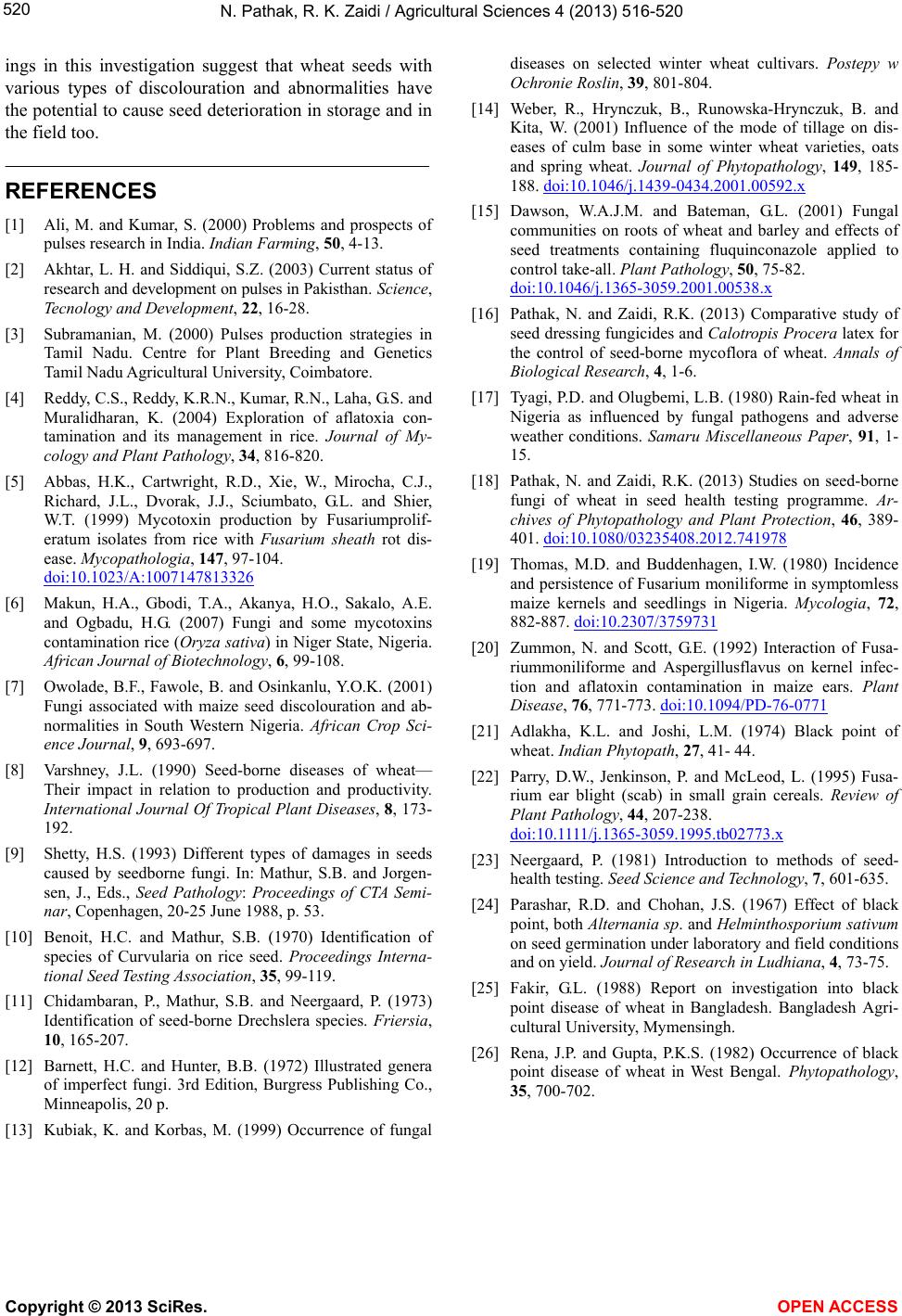
N. Pathak, R. K. Zaidi / Agricultural Sciences 4 (2013) 516-520
520
ings in this investigation suggest that wheat seeds with
various types of discolouration and abnormalities have
the potential to cause seed deterior ation in storage and in
the field too.
REFERENCES
[1] Ali, M. and Kumar, S. (2000) Problems and prospects of
pulses research in India. Indian Farming, 50, 4-13.
[2] Akhtar, L. H. and Siddiqui, S.Z. (2003) Current status of
re se ar ch and development on pulses in Paki st ha n. Science,
Tecnology and Development, 22, 16-28.
[3] Subramanian, M. (2000) Pulses production strategies in
Tamil Nadu. Centre for Plant Breeding and Genetics
Tamil Nadu Agricultural University, Coimbatore.
[4] Reddy, C.S., Reddy, K.R.N., Kumar, R.N., Laha, G.S. and
Muralidharan, K. (2004) Exploration of aflatoxia con-
tamination and its management in rice. Journal of My-
cology and Plant Pathology, 34, 816-820.
[5] Abbas, H.K., Cartwright, R.D., Xie, W., Mirocha, C.J.,
Richard, J.L., Dvorak, J.J., Sciumbato, G.L. and Shier,
W.T. (1999) Mycotoxin production by Fusariumprolif-
eratum isolates from rice with Fusarium sheath rot dis-
ease. Mycopathologia, 147, 97-104.
doi:10.1023/A:1007147813326
[6] Makun, H.A., Gbodi, T.A., Akanya, H.O., Sakalo, A.E.
and Ogbadu, H.G. (2007) Fungi and some mycotoxins
contamination rice (Oryza sativa) in Niger State, Nigeria.
African Journal of Biotechnology, 6, 99-108.
[7] Owolade, B.F., Fawole, B. and Osinkanlu, Y.O.K. (2001)
Fungi associated with maize seed discolouration and ab-
normalities in South Western Nigeria. African Crop Sci-
ence Journal, 9, 693-697.
[8] Varshney, J.L. (1990) Seed-borne diseases of wheat—
Their impact in relation to production and productivity.
International Journal Of Tropical Plant Diseases, 8, 173-
192.
[9] Shetty, H.S. (1993) Different types of damages in seeds
caused by seedborne fungi. In: Mathur, S.B. and Jorgen-
sen, J., Eds., Seed Pathology: Proceedings of CTA Semi-
nar, Copenhagen, 20-25 June 1988, p. 53.
[10] Benoit, H.C. and Mathur, S.B. (1970) Identification of
species of Curvularia on rice seed. Proceedings Interna-
tional Seed Testing Association , 35, 99-119.
[11] Chidambaran, P., Mathur, S.B. and Neergaard, P. (1973)
Identification of seed-borne Drechslera species. Friersia,
10, 165-207.
[12] Barnett, H.C. and Hunter, B.B. (1972) Illustrated genera
of imperfect fungi. 3rd Edition, Burgress Publishing Co.,
Minneapolis, 20 p.
[13] Kubiak, K. and Korbas, M. (1999) Occurrence of fungal
diseases on selected winter wheat cultivars. Postepy w
Ochronie Roslin, 39, 801-804.
[14] Weber, R., Hrynczuk, B., Runowska-Hrynczuk, B. and
Kita, W. (2001) Influence of the mode of tillage on dis-
eases of culm base in some winter wheat varieties, oats
and spring wheat. Journal of Phytopathology, 149, 185-
188. doi:10.1046/j.1439-0434.2001.00592.x
[15] Dawson, W.A.J.M. and Bateman, G.L. (2001) Fungal
communities on roots of wheat and barley and effects of
seed treatments containing fluquinconazole applied to
control take-all. Plant Pathology, 50, 75-82.
doi:10.1046/j.1365-3059.2001.00538.x
[16] Pathak, N. and Zaidi, R.K. (2013) Comparative study of
seed dressing fungicides and Calotropis Procera latex for
the control of seed-borne mycoflora of wheat. Annals of
Biological Research, 4, 1-6.
[17] Tyagi, P.D. and Olugbemi, L.B. (1980) Rain-fed wheat in
Nigeria as influenced by fungal pathogens and adverse
weather conditions. Samaru Miscellaneous Paper, 91, 1-
15.
[18] Pathak, N. and Zaidi, R.K. (2013) Studies on seed-borne
fungi of wheat in seed health testing programme. Ar-
chives of Phytopathology and Plant Protection, 46, 389-
401. doi:10.1080/03235408.2012.741978
[19] Thomas, M.D. and Buddenhagen, I.W. (1980) Incidence
and persistence of Fusarium moniliforme in symptomless
maize kernels and seedlings in Nigeria. Mycologia, 72,
882-887. doi:10.2307/3759731
[20] Zummon, N. and Scott, G.E. (1992) Interaction of Fusa-
riummoniliforme and Aspergillusflavus on kernel infec-
tion and aflatoxin contamination in maize ears. Plant
Disease, 76, 771-773. doi:10.1094/PD-76-0771
[21] Adlakha, K.L. and Joshi, L.M. (1974) Black point of
wheat. Indian Phytopath, 27, 41- 44.
[22] Parry, D.W., Jenkinson, P. and McLeod, L. (1995) Fusa-
rium ear blight (scab) in small grain cereals. Review of
Plant Pathology, 44, 207-238.
doi:10.1111/j.1365-3059.1995.tb02773.x
[23] Neergaard, P. (1981) Introduction to methods of seed-
health testing. Seed Science and Technology, 7, 601-635.
[24] Parashar, R.D. and Chohan, J.S. (1967) Effect of black
point, both Alternania sp. and Helminthosporium sativum
on seed germination under laboratory and field conditions
and on yield. Journal of Research in Ludhiana, 4, 73-75.
[25] Fakir, G.L. (1988) Report on investigation into black
point disease of wheat in Bangladesh. Bangladesh Agri-
cultural University, Mymensingh.
[26] Rena, J.P. and Gupta, P.K.S. (1982) Occurrence of black
point disease of wheat in West Bengal. Phytopathology,
35, 700-702.
Copyright © 2013 SciRes. OPEN ACCESS